tow Citroen DS4 RHD 2013.5 1.G Service Manual
[x] Cancel search | Manufacturer: CITROEN, Model Year: 2013.5, Model line: DS4 RHD, Model: Citroen DS4 RHD 2013.5 1.GPages: 400, PDF Size: 31.86 MB
Page 253 of 400
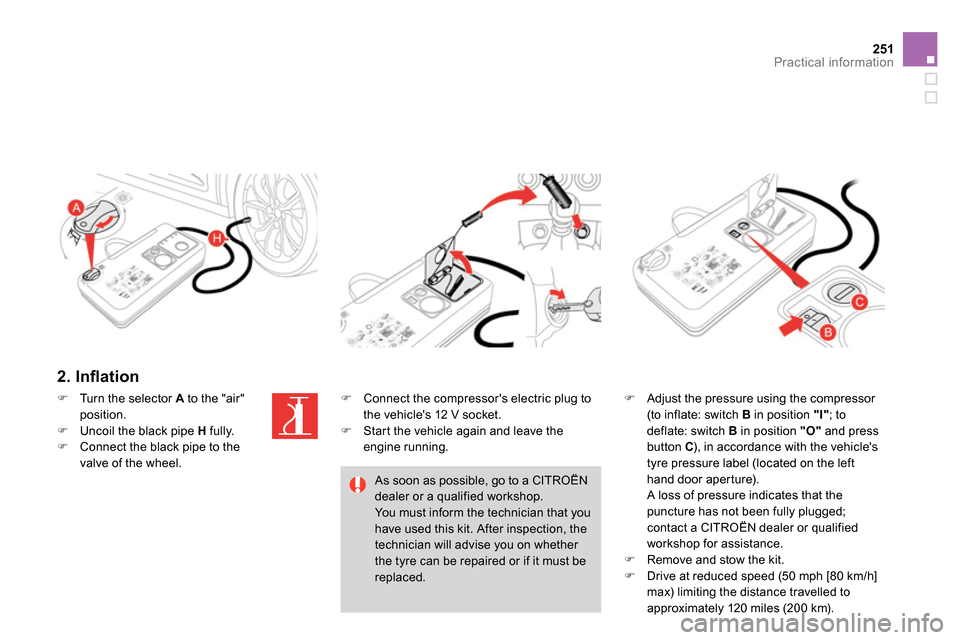
251Practical information
2. Infl ation
Adjust the pressure using the compressor
(to inflate: switch B
in position "I"
; to
deflate: switch B
in position "O"
and press
button C
), in accordance with the vehicle's
tyre pressure label (located on the left
hand door aperture).
A loss of pressure indicates that the
puncture has not been fully plugged;
contact a CITROËN dealer or qualified
workshop for assistance.
Remove and stow the kit.
Drive at reduced speed (50 mph [80 km/h]
max) limiting the distance travelled to
approximately 120 miles (200 km).
Turn the selector A
to the "air"
position.
Uncoil the black pipe H
fully.
Connect the black pipe to the
valve of the wheel.
Connect the compressor's electric plug to
the vehicle's 12 V socket.
Start the vehicle again and leave the
engine running.
As soon as possible, go to a CITROËN
dealer or a qualified workshop.
You must inform the technician that you
have used this kit. After inspection, the
technician will advise you on whether
the tyre can be repaired or if it must be
replaced.
Page 254 of 400
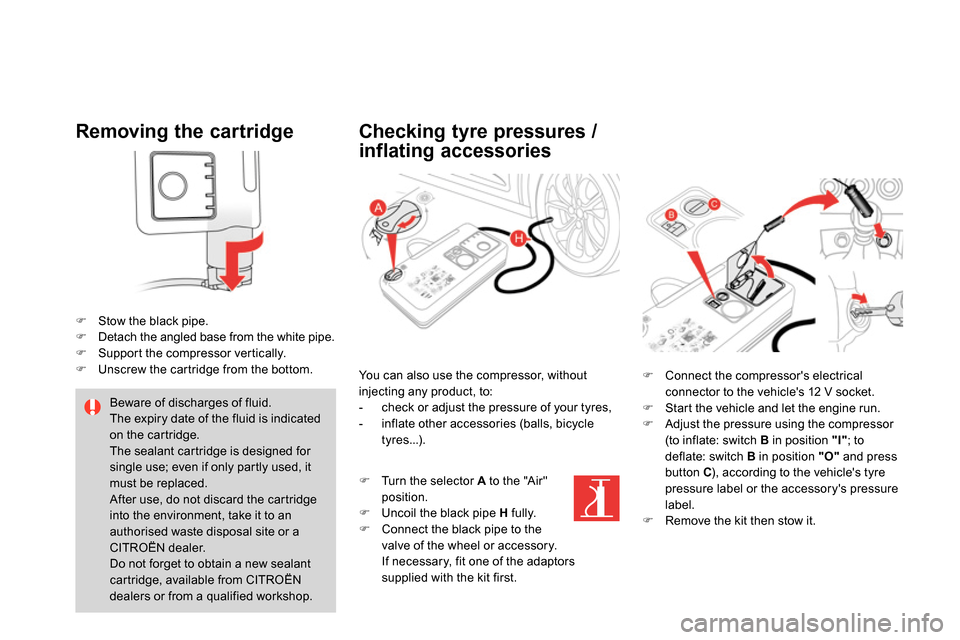
Removing the cartridge
Stow the black pipe.
Detach the angled base from the white pipe.
Support the compressor vertically.
Unscrew the cartridge from the bottom.
Checking tyre pressures /
inflating accessories
Beware of discharges of fluid.
The expiry date of the fluid is indicated
on the cartridge.
The sealant cartridge is designed for
single use; even if only partly used, it
must be replaced.
After use, do not discard the cartridge
into the environment, take it to an
authorised waste disposal site or a
CITROËN dealer.
Do not forget to obtain a new sealant
cartridge, available from CITROËN
dealers or from a qualified workshop.
You can also use the compressor, without
injecting any product, to:
- check or adjust the pressure of your tyres,
- inflate other accessories (balls, bicycle
tyres...).
Connect the compressor's electrical
connector to the vehicle's 12 V socket.
Start the vehicle and let the engine run.
Adjust the pressure using the compressor
(to inflate: switch B
in position "I"
; to
deflate: switch B
in position "O"
and press
button C
), according to the vehicle's tyre
pressure label or the accessory's pressure
label.
Remove the kit then stow it.
Turn the selector A
to the "Air"
position.
Uncoil the black pipe H
fully.
Connect the black pipe to the
valve of the wheel or accessory.
If necessary, fit one of the adaptors
supplied with the kit first.
Page 255 of 400
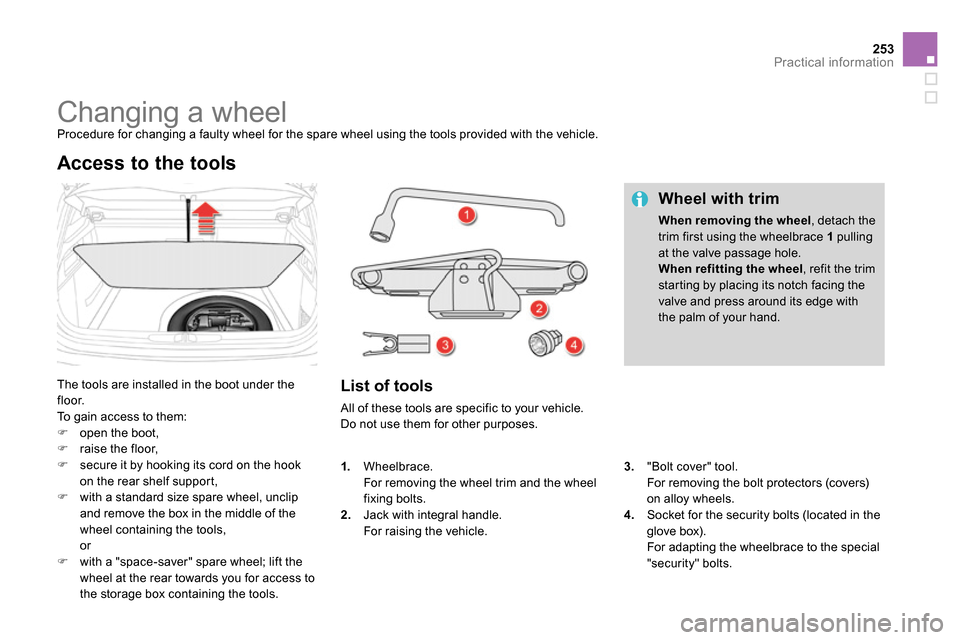
253Practical information
Changing a wheel
Procedure for changing a faulty wheel for the spare wheel using the tools provided with the vehicle.
The tools are installed in the boot under the
floor.
To gain access to them:
open the boot,
raise the floor,
secure it by hooking its cord on the hook
on the rear shelf support,
with a standard size spare wheel, unclip
and remove the box in the middle of the
wheel containing the tools,
or
with a "space-saver" spare wheel; lift the
wheel at the rear towards you for access to
the storage box containing the tools.
Access to the tools
List of tools
All of these tools are specific to your vehicle.
Do not use them for other purposes.
Wheel with trim
When removing the wheel
, detach the
trim first using the wheelbrace 1
pulling
at the valve passage hole.
When refitting the wheel
, refit the trim
starting by placing its notch facing the
valve and press around its edge with
the palm of your hand.
3.
"Bolt cover" tool.
For removing the bolt protectors (covers)
on alloy wheels.
4.
Socket for the security bolts (located in the
glove box).
For adapting the wheelbrace to the special
"security" bolts.
1.
Wheelbrace.
For removing the wheel trim and the wheel
fixing bolts.
2.
Jack with integral handle.
For raising the vehicle.
Page 256 of 400
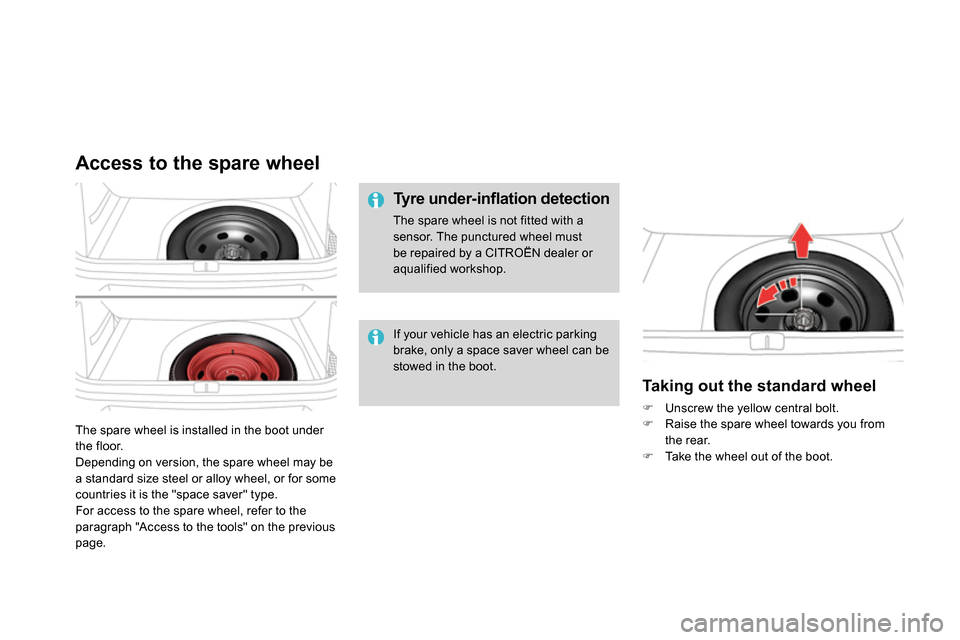
The spare wheel is installed in the boot under
the floor.
Depending on version, the spare wheel may be
a standard size steel or alloy wheel, or for some
countries it is the "space saver" type.
For access to the spare wheel, refer to the
paragraph "Access to the tools" on the previous
page.
Access to the spare wheel
Ty r e u n d e r - i nfl ation detection
The spare wheel is not fitted with a
sensor. The punctured wheel must
be repaired by a CITROËN dealer or
aqualified workshop.
Taking out the standard wheel
Unscrew the yellow central bolt.
Raise the spare wheel towards you from
the rear.
Take the wheel out of the boot.
If your vehicle has an electric parking
brake, only a space saver wheel can be
stowed in the boot.
Page 263 of 400
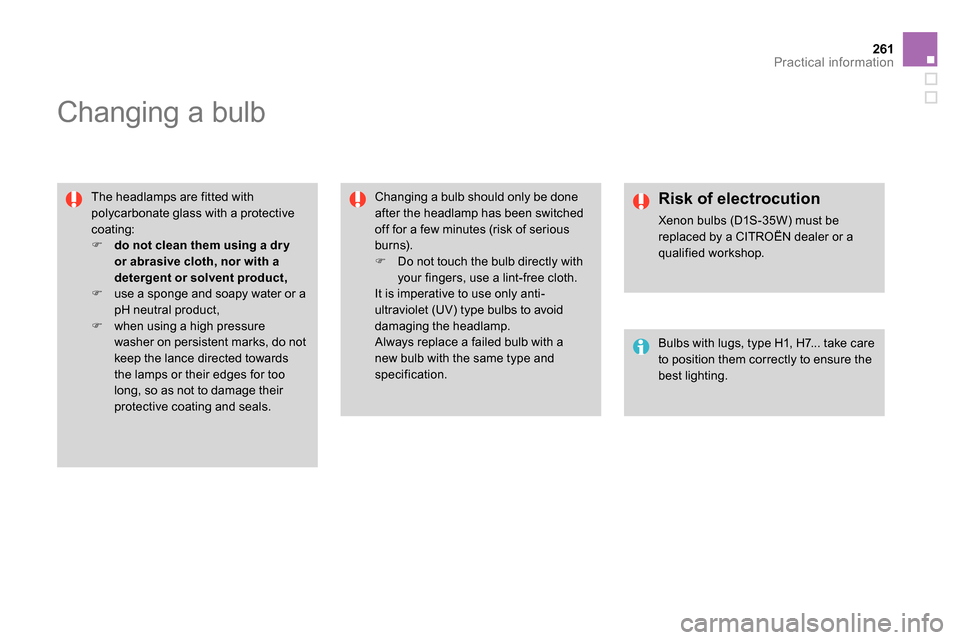
261Practical information
Changing a bulb
The headlamps are fitted with
polycarbonate glass with a protective
coating:
do not clean them using a dr y
or abrasive cloth, nor with a
detergent or solvent product,
use a sponge and soapy water or a
pH neutral product,
when using a high pressure
washer on persistent marks, do not
keep the lance directed towards
the lamps or their edges for too
long, so as not to damage their
protective coating and seals. Changing a bulb should only be done
after the headlamp has been switched
off for a few minutes (risk of serious
burns).
Do not touch the bulb directly with
your fingers, use a lint-free cloth.
It is imperative to use only anti-
ultraviolet (UV) type bulbs to avoid
damaging the headlamp.
Always replace a failed bulb with a
new bulb with the same type and
specification.
Risk of electrocution
Xenon bulbs (D1S-35W) must be
replaced by a CITROËN dealer or a
qualified workshop.
Bulbs with lugs, type H1, H7... take care
to position them correctly to ensure the
best lighting.
Page 266 of 400
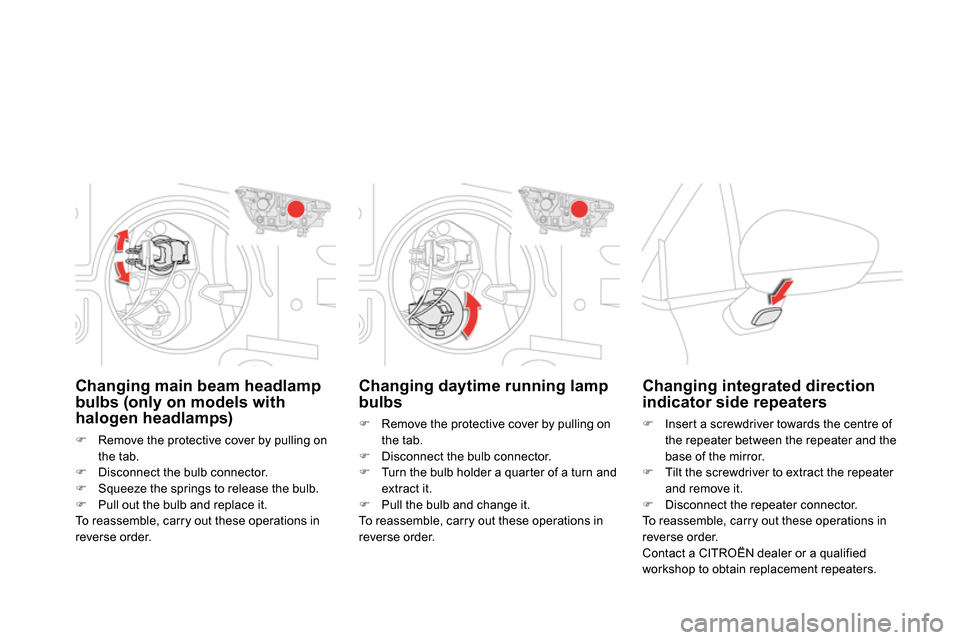
Changing daytime running lamp
bulbs
Remove the protective cover by pulling on
the tab.
Disconnect the bulb connector.
Turn the bulb holder a quarter of a turn and
extract it.
Pull the bulb and change it.
To reassemble, carry out these operations in
reverse order.
Changing main beam headlamp
bulbs (only on models with
halogen headlamps)
Remove the protective cover by pulling on
the tab.
Disconnect the bulb connector.
Squeeze the springs to release the bulb.
Pull out the bulb and replace it.
To reassemble, carry out these operations in
reverse order.
Changing integrated direction
indicator side repeaters
Insert a screwdriver towards the centre of
the repeater between the repeater and the
base of the mirror.
Tilt the screwdriver to extract the repeater
and remove it.
Disconnect the repeater connector.
To reassemble, carry out these operations in
reverse order.
Contact a CITROËN dealer or a qualified
workshop to obtain replacement repeaters.
Page 268 of 400
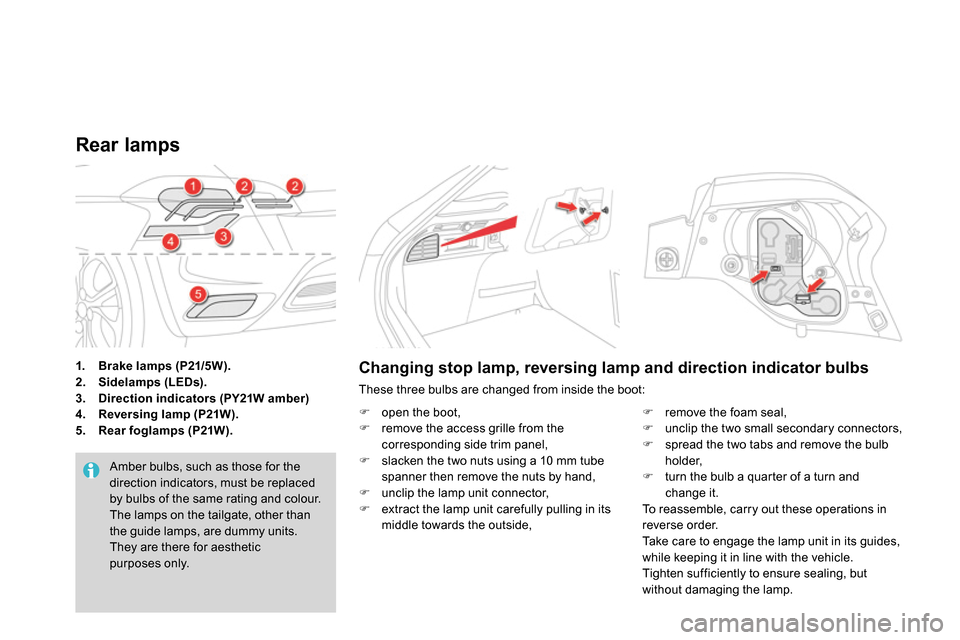
1.
Brake lamps (P21/5W).
2.
Sidelamps (LEDs).
3.
Direction indicators (PY21W amber)
4.
Reversing lamp (P21W).
5.
Rear foglamps (P21W).
Rear lamps
Amber bulbs, such as those for the
direction indicators, must be replaced
by bulbs of the same rating and colour.
The lamps on the tailgate, other than
the guide lamps, are dummy units.
They are there for aesthetic
purposes only.
Changing stop lamp, reversing lamp and direction indicator bulbs
These three bulbs are changed from inside the boot:
open the boot,
remove the access grille from the
corresponding side trim panel,
slacken the two nuts using a 10 mm tube
spanner then remove the nuts by hand,
unclip the lamp unit connector,
extract the lamp unit carefully pulling in its
middle towards the outside,
remove the foam seal,
unclip the two small secondary connectors,
spread the two tabs and remove the bulb
holder,
turn the bulb a quarter of a turn and
change it.
To reassemble, carry out these operations in
reverse order.
Take care to engage the lamp unit in its guides,
while keeping it in line with the vehicle.
Tighten sufficiently to ensure sealing, but
without damaging the lamp.
Page 281 of 400
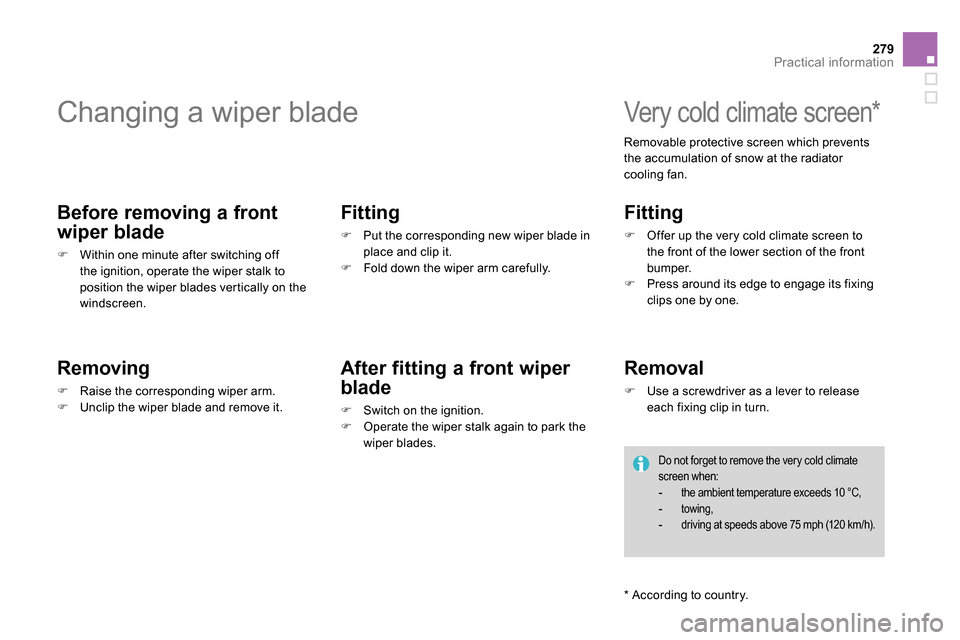
279Practical information
Changing a wiper blade
Before removing a front
wiper blade
Within one minute after switching off
the ignition, operate the wiper stalk to
position the wiper blades vertically on the
windscreen.
Removing
Raise the corresponding wiper arm.
Unclip the wiper blade and remove it.
Fitting
Put the corresponding new wiper blade in
place and clip it.
Fold down the wiper arm carefully.
After fitting a front wiper
blade
Switch on the ignition.
Operate the wiper stalk again to park the
wiper blades.
Very cold climate screen *
Fitting
Offer up the very cold climate screen to
the front of the lower section of the front
bumper.
Press around its edge to engage its fixing
clips one by one.
Removal
Use a screwdriver as a lever to release
each fixing clip in turn.
* According to country.
Do not forget to remove the very cold climate
screen when:
-
the ambient temperature exceeds 10 °C,
-
towing,
-
driving at speeds above 75 mph (120 km/h).
Removable protective screen which prevents
the accumulation of snow at the radiator
cooling fan.
Page 283 of 400
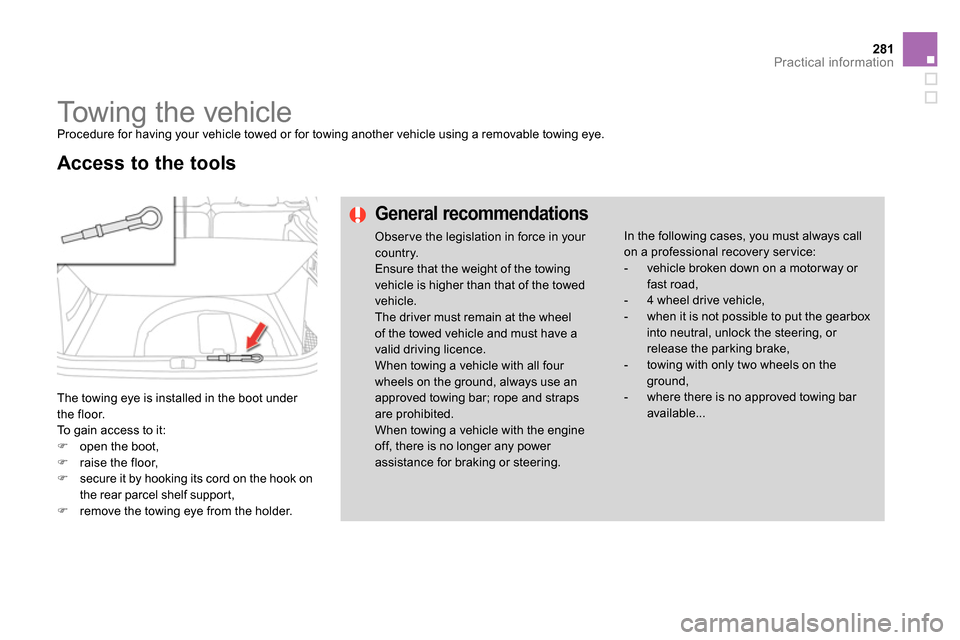
281Practical information
Towing the vehicle
Procedure for having your vehicle towed or for towing another vehicle using a removable towing eye.
The towing eye is installed in the boot under
the floor.
To gain access to it:
open the boot,
raise the floor,
secure it by hooking its cord on the hook on
the rear parcel shelf support,
remove the towing eye from the holder.
Access to the tools
General recommendations
Observe the legislation in force in your
country.
Ensure that the weight of the towing
vehicle is higher than that of the towed
vehicle.
The driver must remain at the wheel
of the towed vehicle and must have a
valid driving licence.
When towing a vehicle with all four
wheels on the ground, always use an
approved towing bar; rope and straps
are prohibited.
When towing a vehicle with the engine
off, there is no longer any power
assistance for braking or steering. In the following cases, you must always call
on a professional recovery ser vice:
- vehicle broken down on a motor way or
fast road,
- 4 wheel drive vehicle,
- when it is not possible to put the gearbox
into neutral, unlock the steering, or
release the parking brake,
- towing with only two wheels on the
ground,
- where there is no approved towing bar
available...
Page 284 of 400
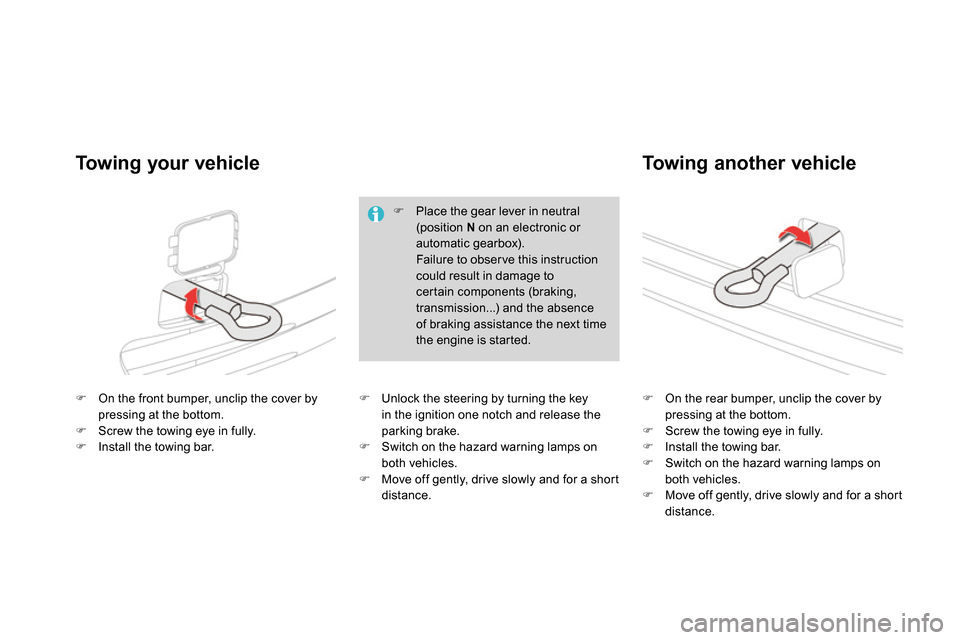
On the front bumper, unclip the cover by
pressing at the bottom.
Screw the towing eye in fully.
Install the towing bar.
On the rear bumper, unclip the cover by
pressing at the bottom.
Screw the towing eye in fully.
Install the towing bar.
Switch on the hazard warning lamps on
both vehicles.
Move off gently, drive slowly and for a short
distance.
Towing your vehicle
Towing another vehicle
Place the gear lever in neutral
(position N
on an electronic or
automatic gearbox).
Failure to obser ve this instruction
could result in damage to
certain components (braking,
transmission...) and the absence
of braking assistance the next time
the engine is started.
Unlock the steering by turning the key
in the ignition one notch and release the
parking brake.
Switch on the hazard warning lamps on
both vehicles.
Move off gently, drive slowly and for a short
distance.